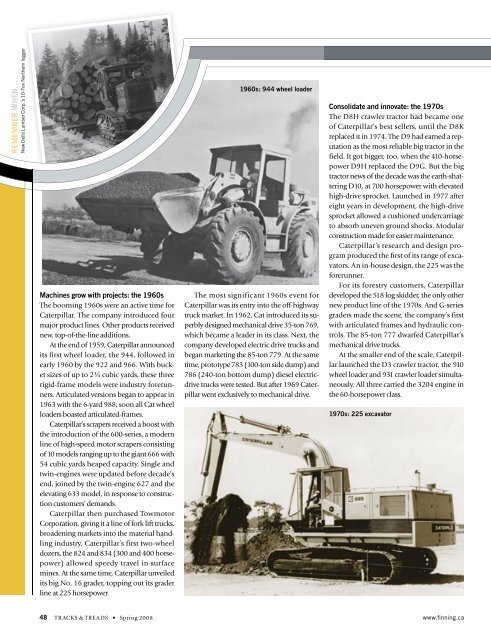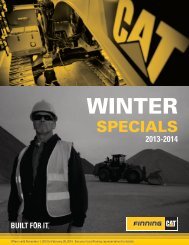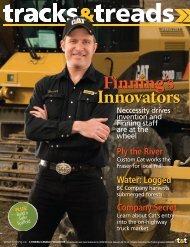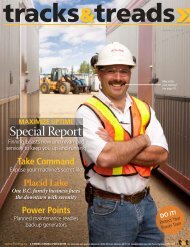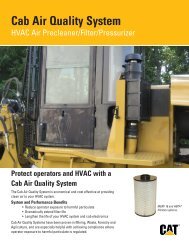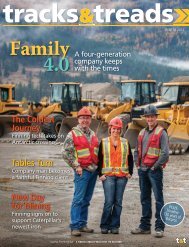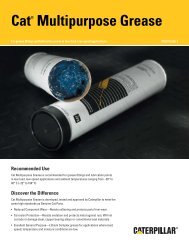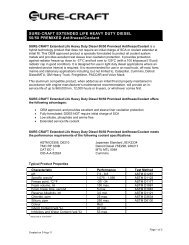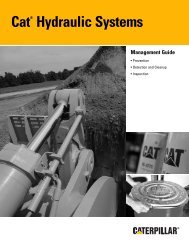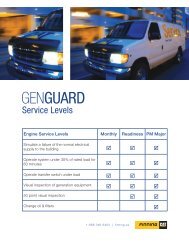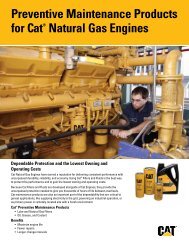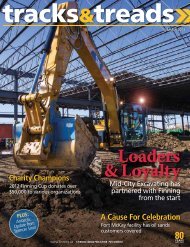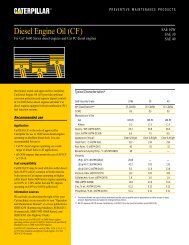Everyday Heroes: Meet Finning's service ... - Finning Canada
Everyday Heroes: Meet Finning's service ... - Finning Canada
Everyday Heroes: Meet Finning's service ... - Finning Canada
You also want an ePaper? Increase the reach of your titles
YUMPU automatically turns print PDFs into web optimized ePapers that Google loves.
REMEMBER WHEN…New Dells Lumber Corp.’s 10-Ton Northern loggerMachines grow with projects: the 1960sThe booming 1960s were an active time forCaterpillar. The company introduced fourmajor product lines. Other products receivednew, top-of-the-line additions.At the end of 1959, Caterpillar announcedits first wheel loader, the 944, followed inearly 1960 by the 922 and 966. With bucketsizes of up to 2¾ cubic yards, these threerigid-frame models were industry forerunners.Articulated versions began to appear in1963 with the 6-yard 988; soon all Cat wheelloaders boasted articulated-frames.Caterpillar’s scrapers received a boost withthe introduction of the 600-series, a modernline of high-speed motor scrapers consistingof 10 models ranging up to the giant 666 with54 cubic yards heaped capacity. Single andtwin-engines were updated before decade’send, joined by the twin-engine 627 and theelevating 633 model, in response to constructioncustomers’ demands.Caterpillar then purchased TowmotorCorporation, giving it a line of fork lift trucks,broadening markets into the material hand -ling industry. Caterpillar’s first two-wheeldozers, the 824 and 834 (300 and 400 horsepower)allowed speedy travel in surfacemines. At the same time, Caterpillar unveiledits big No. 16 grader, topping out its graderline at 225 horsepower.1960s: 944 wheel loaderThe most significant 1960s event forCaterpillar was its entry into the off-highwaytruck market. In 1962, Cat introduced its superblydesigned mechanical drive 35-ton 769,which became a leader in its class. Next, thecompany developed electric drive trucks andbegan marketing the 85-ton 779. At the sametime, prototype 783 (100-ton side dump) and786 (240-ton bottom dump) diesel electricdrivetrucks were tested. But after 1969 Caterpillarwent exclusively to mechanical drive.Consolidate and innovate: the 1970sThe D8H crawler tractor had became oneof Caterpillar’s best sellers, until the D8Kreplaced it in 1974. The D9 had earned a reputationas the most reliable big tractor in thefield. It got bigger, too, when the 410-horsepowerD9H replaced the D9G. But the bigtractor news of the decade was the earth-shatteringD10, at 700 horsepower with elevatedhigh-drive sprocket. Launched in 1977 aftereight years in development, the high-drivesprocket allowed a cushioned undercarriageto absorb uneven ground shocks. Modularconstruction made for easier maintenance.Caterpillar’s research and design programproduced the first of its range of excavators.An in-house design, the 225 was theforerunner.For its forestry customers, Caterpillardeveloped the 518 log skidder, the only othernew product line of the 1970s. And G-seriesgraders made the scene, the company’s firstwith articulated frames and hydraulic controls.The 85-ton 777 dwarfed Caterpillar’smechanical drive trucks.At the smaller end of the scale, Caterpillarlaunched the D3 crawler tractor, the 910wheel loader and 931 crawler loader simultaneously.All three carried the 3204 engine inthe 60-horsepower class.1970s: 225 excavator48 TRACKS & TREADS • Spring 2008 www.finning.ca


